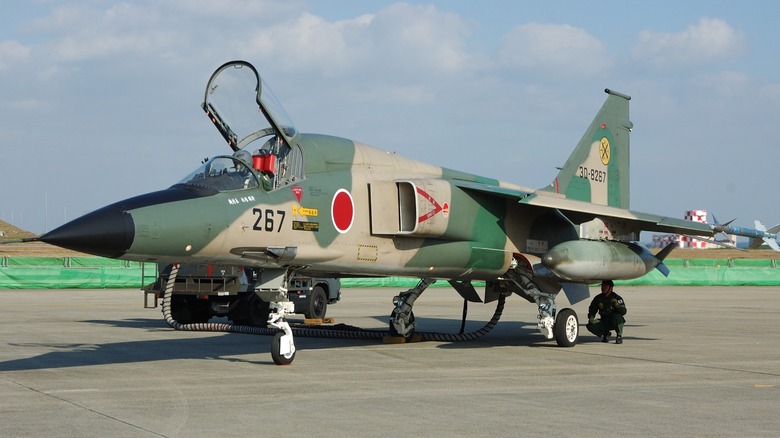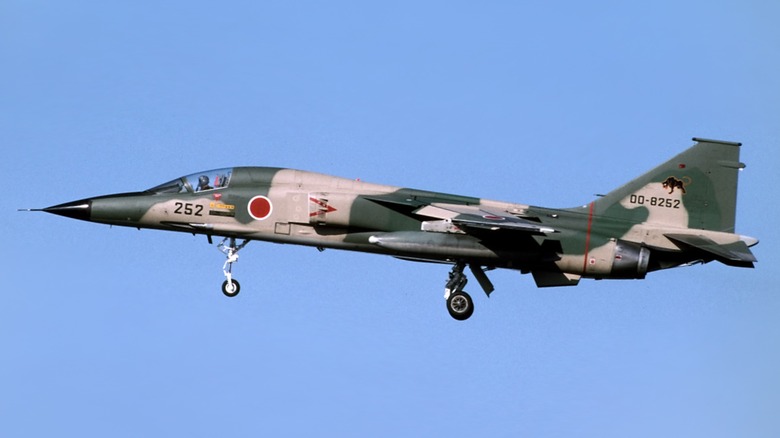What Was Japan's First Fighter Jet After WW2?
During World War II, Japan was exceptionally innovative in aviation. The nation produced the infamous Mitsubishi A6M "Zero," which devastated the Allies in the early phases of the conflict, and other planes proved deadly. Japan even built a secret jet fighter, the Nakajima Kikka, though it wasn't completed before the war ended in 1945. After WWII, Japan was placed under strict enforcement to ensure it used its military only for defensive purposes, but the nation finally developed its own strike aircraft in the 1970s.
Initially, the Japan Air Self-Defense Force (JASDF) sought to construct a jet trainer after using the American-produced F-86 Sabre for years. The nation required a faster supersonic trainer to prepare its pilots for the forthcoming U.S.-made F-104 Starfighters, which unfortunately earned the moniker "Widowmaker." In 1971 Japan succeeded with the Mitsubishi T-2. It was used as the basis for the development of a strike aircraft for anti-ship and airborne defensive purposes.
Finally, in 1975, after years of development and testing, the JASDF had its own strike aircraft in the Mitsubishi F-1. Because the JASFD was small at the time, and remains relatively small today, only 77 were completed throughout the production life of the F-1, which concluded in 1981. The F-1 proved itself reliable and agile as a strike aircraft, and the JASDF received its first delivery in 1977. The aircraft remained in service until 2006, though by that point, more modern platforms were available and much of the JASDF's inventory included licensed F-15 Eagles and F-2s derived from the F-16 Fighting Falcon.
Japan's Mitsubishi F-1 improved Japan's self-defensive capabilities
The Mitsubishi F-1 was a strike aircraft, but given its payload capabilities, it was more of a light bomber. It was armed with a 20mm JM61A1 Vulcan six-barreled gatling cannon and had a payload capacity of nearly 6,000 pounds of rockets and bombs it could fire or drop from its seven hardpoints. Notably, it could carry the AIM-9L Sidewinder, the world's first infrared-homing (heat-seeking) air-to-air missile that's still in use today. This made the F-1 a deadly interceptor, which isn't the same as a fighter.
Other armaments included the Mitsubishi ASM-1 anti-ship missile and a variety of 70mm and 125mm rockets fired from pods. The F-1 was outfitted with two Rolls-Royce/Turbomeca turbojet engines, capable of providing a combined 10,230 pounds of thrust. The F-1 had a maximum speed of Mach 1.37 (1,056 mph) and a ceiling of 50,000 feet. While that made it comparable to other strike aircraft of the era, its range was comparatively low.
The F-1 could only fly a distance of 345 miles, which sounds far if you're driving the family to an amusement park, but in a jet, it's a short range. That said, it did have a larger ferry range of 1,783 miles. For comparison, the F-15A, which was introduced around the same time, had a non-ferry range of 3,450 miles with external fuel tanks. Because the JASDF used the F-1 entirely for its own national defense, a greater range wasn't required, so the F-1 performed as desired.

